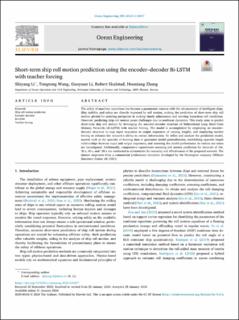| dc.contributor.author | Li, Shiyang | |
| dc.contributor.author | Wang, Tongtong | |
| dc.contributor.author | Li, Guoyuan | |
| dc.contributor.author | Skulstad, Robert | |
| dc.contributor.author | Zhang, Houxiang | |
| dc.date.accessioned | 2024-02-28T09:38:56Z | |
| dc.date.available | 2024-02-28T09:38:56Z | |
| dc.date.created | 2024-02-20T10:05:11Z | |
| dc.date.issued | 2024 | |
| dc.identifier.issn | 0029-8018 | |
| dc.identifier.uri | https://hdl.handle.net/11250/3120264 | |
| dc.description.abstract | The safety of maritime operations has become a paramount concern with the advancement of intelligent ships. Ship stability and safety are directly impacted by roll motion, making the prediction of short-term ship roll motion pivotal for assisting navigators in making timely adjustments and averting hazardous roll conditions. However, predicting ship roll motion poses challenges due to nonlinear dynamics. This study aims to predict short-term ship roll motion by leveraging the encoder–decoder structure of Bidirectional Long Short-Term Memory Networks (Bi-LSTM) with teacher forcing. The model is accomplished by employing an encoder–decoder structure to map input sequences to output sequences of varying lengths, and employing teacher forcing to enhance the network’s ability to extract information. To refine and analyze the prediction model, aspects such as the quantity of training data to guarantee model generalization, establishing apposite length relationships between input and output sequences, and assessing the model performance in various sea states are investigated. Additionally, comparative experiments assessing roll motion prediction for intervals of 10s, 30 s, 60 s, and 120 s are conducted to substantiate the necessity and effectiveness of the proposed network. The dataset originates from a commercial professional simulator developed by the Norwegian company Offshore Simulator Center AS (OSC). | en_US |
| dc.language.iso | eng | en_US |
| dc.publisher | Elsevier B. V. | en_US |
| dc.rights | Navngivelse 4.0 Internasjonal | * |
| dc.rights.uri | http://creativecommons.org/licenses/by/4.0/deed.no | * |
| dc.title | Short-term ship roll motion prediction using the encoder–decoder Bi-LSTM with teacher forcing | en_US |
| dc.title.alternative | Short-term ship roll motion prediction using the encoder–decoder Bi-LSTM with teacher forcing | en_US |
| dc.type | Peer reviewed | en_US |
| dc.type | Journal article | en_US |
| dc.description.version | acceptedVersion | en_US |
| dc.source.volume | 295 | en_US |
| dc.source.journal | Ocean Engineering | en_US |
| dc.identifier.doi | 10.1016/j.oceaneng.2024.116917 | |
| dc.identifier.cristin | 2247883 | |
| dc.source.articlenumber | 116917 | en_US |
| cristin.ispublished | true | |
| cristin.fulltext | postprint | |
| cristin.qualitycode | 1 | |

